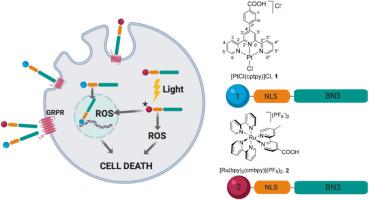Journal of Inorganic Biochemistry ( IF 3.8 ) Pub Date : 2020-08-10 , DOI: 10.1016/j.jinorgbio.2020.111214 Sílvia Barrabés 1 , Iteng Ng-Choi 2 , María Ángeles Martínez 2 , Blanca R Manzano 3 , Félix A Jalón 3 , Gustavo Espino 4 , Lidia Feliu 2 , Marta Planas 2 , Rafael de Llorens 1 , Anna Massaguer 1

|
We have synthesized a set of bombesin derivatives with the aim of exploring their tumor targeting properties to deliver metal-based chemotherapeutics into cancer cells. Peptide QRLGNQWAVGHLL-NH2 (BN3) was selected based on its high internalization in gastrin-releasing peptide receptor (GRPR)-overexpressing PC-3 cells. Three metallopeptides were prepared by incorporating the terpyridine Pt(II) complex [PtCl(cptpy)]Cl (1) (cptpy = 4′-(4-carboxyphenyl)-2,2′:6,2″-terpyridine) at the N-terminus of BN3 or at the NƐ- or Nα-amino group of an additional Lys residue (1-BN3, Lys-1-BN3 and 1-Lys-BN3, respectively). 1-Lys-BN3 displayed the best cytotoxic activity (IC50: 19.2 ± 1.7 μM) and similar ability to intercalate into DNA than complex 1. Moreover, the polypyridine Ru(II) complex [Ru(bpy)2)(cmbpy)](PF6)2 (2) (bpy = 2,2′-bipyridine; cmbpy = 4-methyl-2,2′-bipyridine-4′-carboxylic acid), with proven activity as photosensitizer, was coupled to BN3 leading to metallopeptide 2-Lys-BN3. Upon photoactivation, 2-Lys-BN3 displayed 2.5-fold higher cytotoxicity against PC-3 cells (IC50: 7.6 ± 1.0 μM) than complex 2. To enhance the accumulation of the drugs into the cell nucleus, the nuclear localization signal (NLS) PKKKRKV was incorporated at the N-terminus of BN3. NLS-BN3 displayed higher cellular internalization along with nuclear biodistribution. Accordingly, metallopeptides 1-NLS-BN3 and 2-NLS-BN3 showed increased cytotoxicity (IC50: 12.0 ± 1.1 μM and 2.3 ± 1.1 μM). Interestingly, the phototoxic index of 2-NLS-BN3 was 8-fold higher than that of complex 2. Next, the selectivity towards cancer cells was explored using 1BR3.G fibroblasts. Higher selectivity indexes were obtained for 1-NLS-BN3 and 2-NLS-BN3 than for the unconjugated complexes. These results prove NLS-BN3 effective for targeted delivery of metallodrugs to GRPR-overexpressing cells and for enhancing the cytotoxic efficacy of metal-based photosensitizers.
中文翻译:

一种核定向的铃蟾肽衍生物,用于将金属药物靶向递送至癌细胞。
我们合成了一组铃蟾肽衍生物,旨在探索它们的肿瘤靶向特性,以将基于金属的化疗药物输送到癌细胞中。选择肽 QRLGNQWAVGHLL-NH 2 ( BN3 ) 是基于其在胃泌素释放肽受体 (GRPR) 过表达的 PC-3 细胞中的高度内化。三个metallopeptides分别通过将三联吡啶制备的Pt(II)络合物[氯铂酸(cptpy)]氯(1)(cptpy = 4' - (4-羧基苯基)-2,2':6,2“ -三联吡啶)在N -末端的BN3或在ñ ɛ -或ñ α -氨基基团的附加Lys残基的(1-BN3,赖氨酸-1- BN3和1-赖氨酸BN3, 分别)。1-Lys-BN3显示出最好的细胞毒活性 (IC 50 : 19.2 ± 1.7 μM) 和与复合物1相比类似的嵌入 DNA 的能力。此外,多吡啶Ru(II)配合物[Ru(bpy) 2 )(cmbpy)](PF 6 ) 2 ( 2 ) (bpy = 2,2'-联吡啶;cmbpy = 4-甲基-2,2'-联吡啶-4'-羧酸),具有作为光敏剂的证明活性,与BN3偶联产生金属肽2-Lys-BN3。光活化后,2-Lys-BN3对 PC-3 细胞的细胞毒性比复合物2高 2.5 倍(IC 50:7.6 ± 1.0 μM). 为了增强药物在细胞核中的积累,核定位信号 (NLS) PKKKRKV 被纳入BN3的 N 端。NLS-BN3显示出更高的细胞内化以及核生物分布。因此,金属肽1-NLS-BN3和2-NLS-BN3显示出增加的细胞毒性(IC 50:12.0 ± 1.1 μM 和 2.3 ± 1.1 μM)。有趣的是,2-NLS-BN3的光毒性指数是复合物2 的8 倍。接下来,使用 1BR3.G 成纤维细胞探索了对癌细胞的选择性。1-NLS-BN3和2-NLS-BN3获得了更高的选择性指数而不是非共轭配合物。这些结果证明NLS-BN3 可有效地将金属药物靶向递送至 GRPR 过表达细胞并增强基于金属的光敏剂的细胞毒性功效。









































 京公网安备 11010802027423号
京公网安备 11010802027423号